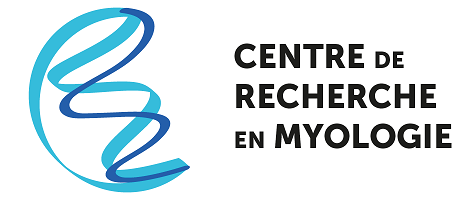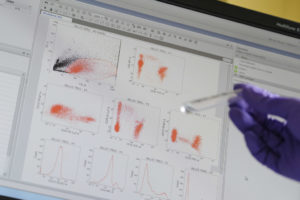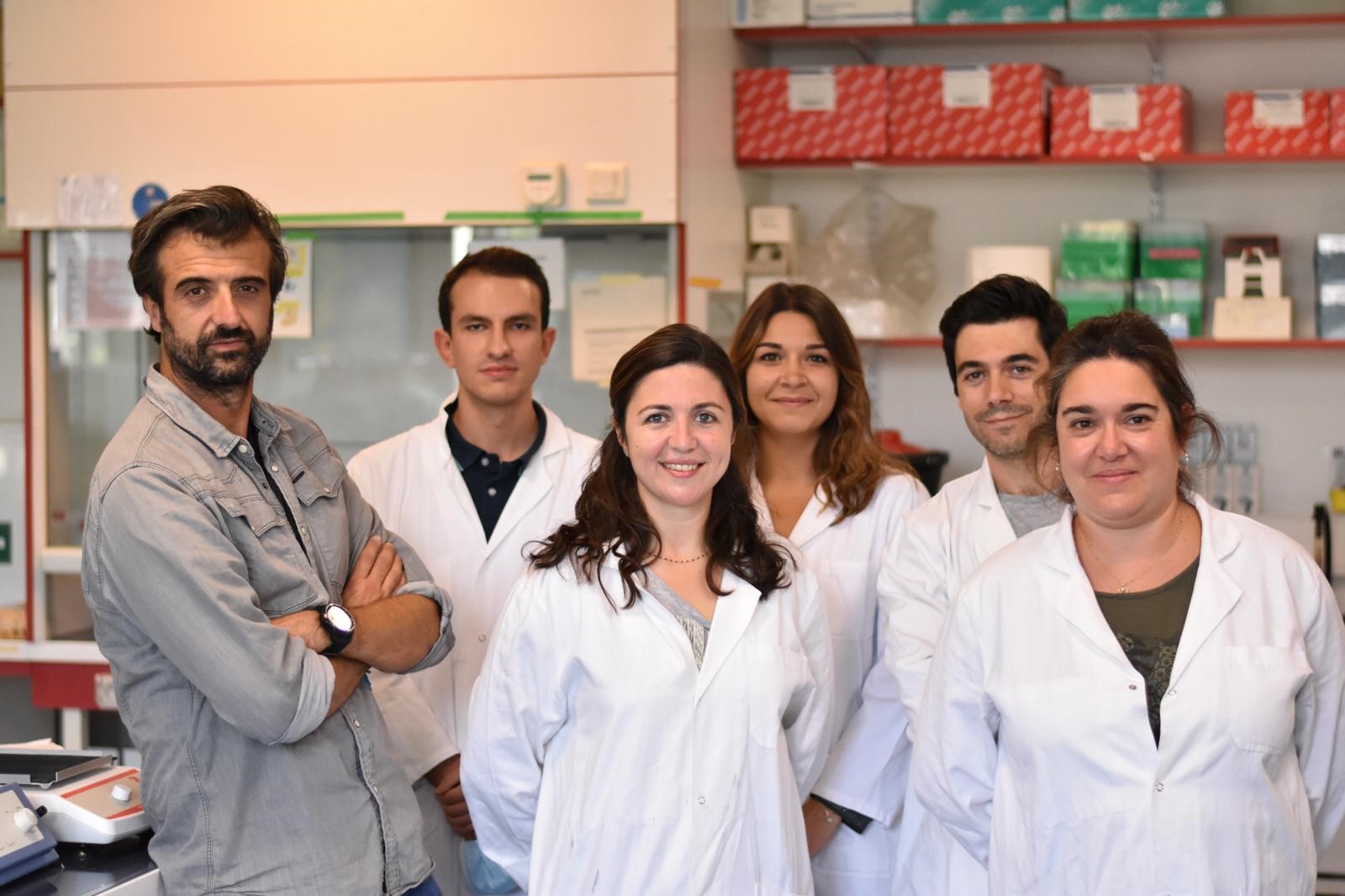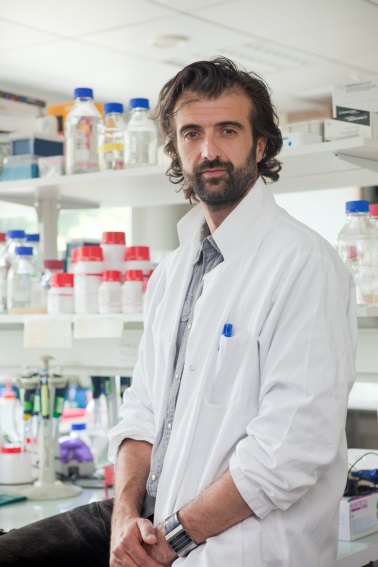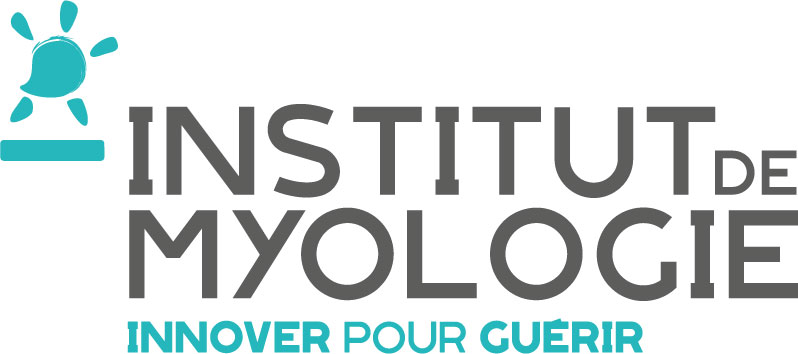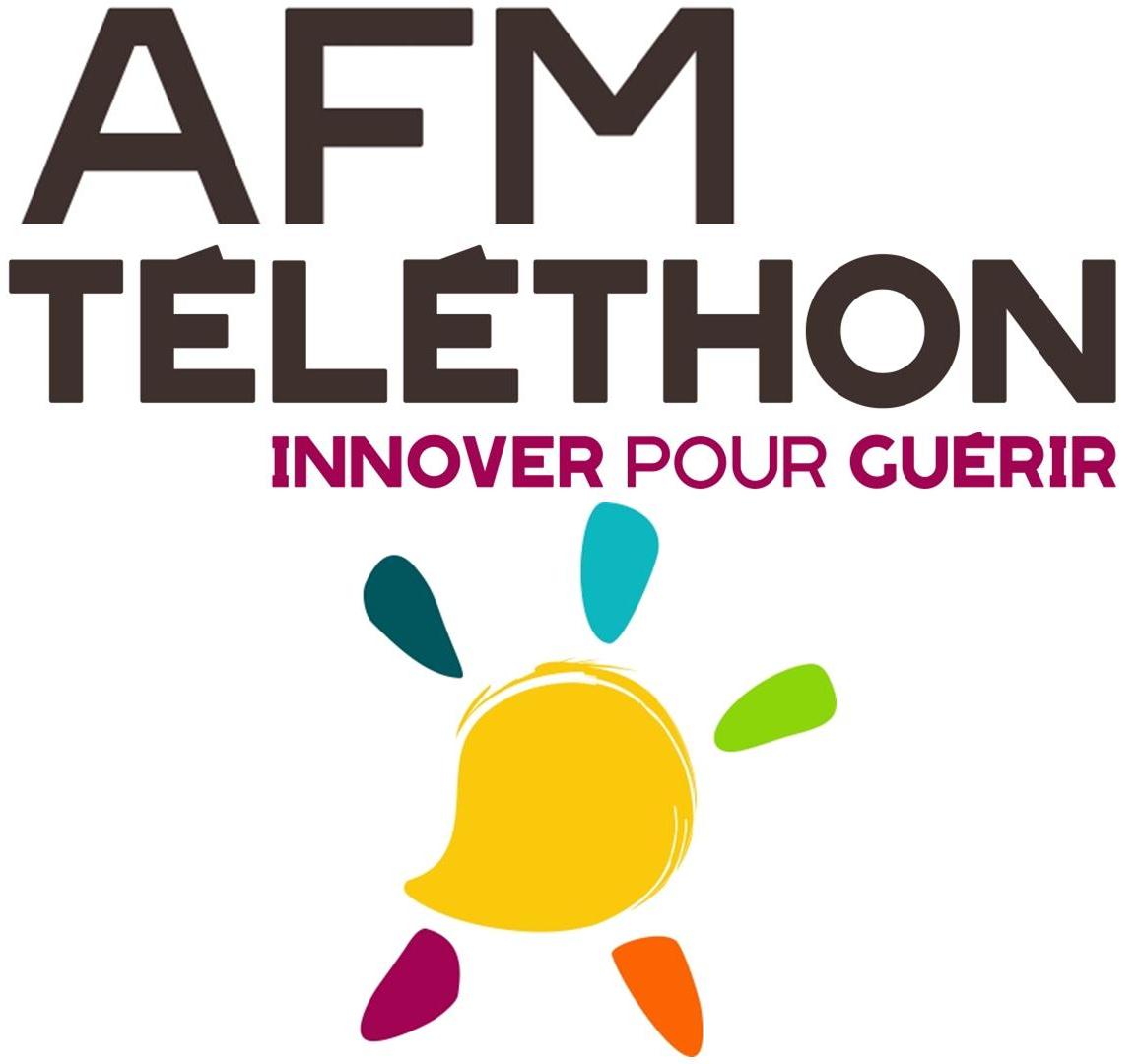Signal pathways and striated muscles
Striated muscles account for about 40% of total body weight, contain 50-75% of the body’s total protein and contribute significantly to multiple body functions. There are two types of striated muscle: skeletal and cardiac muscles. They share a common architecture characterized by a very particular and well described arrangement of muscle cells and associated connective tissues.
Muscular dystrophies correspond to a family of muscle diseases characterized by weakness and progressive muscle degeneration. At the skeletal muscular level, they manifest themselves by a decrease in muscle strength (muscular dystrophy), and a lack of mobilité́ joints (muscle retractions) that begin in childhood or in young adults. The decrease in muscle strength leads, in a few cases, to a loss of independent walking, making it necessary to use a power wheelchair to get around. These are diseases of genetic origin. There are several forms that differ in the age of onset of symptoms, the nature of the muscles affected and their severity. At the cardiac level, the presence of abnormalities is observed at a more or less advanced age, mainly in the form of dilated cardiomyopathy, which is the main cause of death and makes the severity of these diseases. At present, there is no curative treatment available.
Our group is particularly interested in studying the molecular and cellular mechanisms involved in two muscular dystrophies: Duchenne muscular dystrophy and Emery-Dreifuss muscular dystrophy. It appears important and necessary to increase our knowledge of the pathophysiology of muscular dystrophies and cardiomyopathies in order to unveil the cellular/molecular mechanisms that will allow us to target future therapeutic approaches. We are studying in vitro and in vivo models of these pathologies and developing novel pharmacological therapies based on our discoveries.
Our research is based on 3 axes:
- Tissue organization of striated muscles in health and pathology
- Signalling pathways regulating the links between structure and function in striated muscles
- Control of striated muscle gene expression through signalling pathways
| Name | Position | ORCID |
|---|
Journal articles
- Massiré Traoré, Chiara Noviello, Amélie Vergnol, Christel Gentil, Marius Halliez, et al.. GDF5 as a rejuvenating treatment for age-related neuromuscular failure. Brain - A Journal of Neurology , 2024, 147, pp.3834 - 3848. ⟨10.1093/brain/awae107⟩. ⟨hal-04760455⟩
- Marine Ferrand, Gauthier Giordano, Nathalie Mougenot, Pierre-Léo Laporte, Nicolas Vignier, et al.. Intracardiac electrophysiology to characterize susceptibility to ventricular arrhythmias in murine models. Frontiers in Physiology, 2024, 15, ⟨10.3389/fphys.2024.1326663⟩. ⟨hal-04446798⟩
- Pauline Garcia, William Jarassier, Caroline Brun, Lorenzo Giordani, Fany Agostini, et al.. Setdb1 protects genome integrity in murine muscle stem cells to allow for regenerative myogenesis and inflammation. Developmental Cell, 2024, 59 (17), pp.2375-2392.e8. ⟨10.1016/j.devcel.2024.05.012⟩. ⟨hal-04747691⟩
- Laura Vanden Brande, Stéphanie Bauché, Laura Pérez-Guàrdia, Damien Sternberg, Andreea Seferian, et al.. Pathogenic DPAGT1 variants in limb‐girdle congenital myasthenic syndrome (LG‐CMS) associated with tubular aggregates and ORAI1 hypoglycosylation. Neuropathology and Applied Neurobiology, 2023, 50 (1), ⟨10.1111/nan.12952⟩. ⟨hal-04409827⟩
- Brandon H. Hayes, Timothée Vergne, Mathieu Andraud, Nicolas Rose. Mathematical modeling at the livestock-wildlife interface: scoping review of drivers of disease transmission between species. Frontiers in Veterinary Science, 2023, 10, pp.1225446. ⟨10.3389/fvets.2023.1225446⟩. ⟨hal-04223851⟩
- Maria-Belen Lopez-Herdoiza, Stéphanie Bauché, Baptiste Wilmet, Caroline Le Duigou, Delphine Roussel, et al.. C9ORF72 knockdown triggers FTD-like symptoms and cell pathology in mice. Frontiers in Cellular Neuroscience, 2023, 17, ⟨10.3389/fncel.2023.1155929⟩. ⟨hal-04191782⟩
- Marion Masingue, Olivia Cattaneo, Nicolas Wolff, Céline Buon, Damien Sternberg, et al.. New mutation in the β1 propeller domain of LRP4 responsible for congenital myasthenic syndrome associated with Cenani–Lenz syndrome. Scientific Reports, 2023, 13 (1), pp.14054. ⟨10.1038/s41598-023-41008-5⟩. ⟨hal-04191765⟩
- Caroline Le Dour, Maria Chatzifrangkeskou, Coline Macquart, Maria M Magiera, Cécile Peccate, et al.. Actin-microtubule cytoskeletal interplay mediated by MRTF-A/SRF signaling promotes dilated cardiomyopathy caused by LMNA mutations. Nature Communications, 2022, 13 (1), pp.7886. ⟨10.1038/s41467-022-35639-x⟩. ⟨hal-03921784⟩
- Nicolas Rose, Berenice Estrada Chavez, Surabhi Sonam, Thao Nguyen, Gianluca Grenci, et al.. Bioengineering a Miniaturized In Vitro 3D Myotube Contraction Monitoring Chip To Model Muscular Dystrophies. Biomaterials, 2022, ⟨10.1016/j.biomaterials.2022.121935⟩. ⟨hal-03278692⟩
- Chiara D’ercole, Paolo D’angelo, Veronica Ruggieri, Daisy Proietti, Laura Virtanen, et al.. Spatially resolved transcriptomics reveals innervation-responsive functional clusters in skeletal muscle. Cell Reports, 2022, 41 (12), pp.111861. ⟨10.1016/j.celrep.2022.111861⟩. ⟨hal-04019028⟩
- Tanya Stojkovic, Marion Masingue, Helène Turmel, Marianne Hezode-Arzel, Anthony Béhin, et al.. Diagnostic yield of a practical electrodiagnostic protocol discriminating between different congenital myasthenic syndromes. Neuromuscular Disorders, 2022, 32 (11-12), pp.870-878. ⟨10.1016/j.nmd.2022.10.001⟩. ⟨hal-04074000⟩
- Marie Kervella, Maureen Jahier, Albano C. Meli, Antoine Muchir. Genome organization in cardiomyocytes expressing mutated A-type lamins. Frontiers in Cell and Developmental Biology, 2022, 10, pp.1030950. ⟨10.3389/fcell.2022.1030950⟩. ⟨hal-03817271⟩
- Stéphanie Mulot, Nicolas Vignier, Mayka Mergeay-Fabre, Agnès Clerc-Renaud, Guillaume Odonne, et al.. Journée scientifique Covid et société en Guyane et aux Antilles - 25 mars 2022 - Cayenne, Guyane. Médecine Tropicale et Santé Internationale, 2022, 2 (3). ⟨hal-04100633⟩
- Nicolas Vignier, Sohela Moussaoui, Antoine Marsaudon, Jérome Wittwer, Florence Jusot, et al.. Frontiers in Public Health. Frontiers in Public Health, 2022, 10. ⟨hal-03959709⟩
- Nicolas Vignier, Maria Chatzifrangkeskou, Luca Pinton, Hugo Wioland, Thibaut Marais, et al.. The non-muscle ADF/cofilin-1 controls sarcomeric actin filament integrity and force production in striated muscle laminopathies. Cell Reports, 2021, 36 (8), pp.109601. ⟨10.1016/j.celrep.2021.109601⟩. ⟨hal-03350074⟩
- Mohammad Haroon, Jenneke Klein-Nulend, Astrid D Bakker, Jianfeng Jin, Hadi Seddiqi, et al.. Myofiber stretch induces tensile and shear deformation of muscle stem cells in their native niche. Biophysical Journal, 2021, 120 (13), pp.2665 - 2678. ⟨10.1016/j.bpj.2021.05.021⟩. ⟨hal-03296015⟩
- Daisy Proietti, Lorenzo Giordani, Marco de Bardi, Chiara d'Ercole, Biliana Lozanoska-Ochser, et al.. Activation of skeletal muscle-resident glial cells upon nerve injury. JCI Insight, 2021, ⟨10.1172/jci.insight.143469⟩. ⟨hal-03160815⟩
- Anne-Claire Guenantin, Imen Jebeniani, Julia Leschik, Erwan Watrin, Gisèle Bonne, et al.. Targeting the histone demethylase LSD1 prevents cardiomyopathy in a mouse model of laminopathy. Journal of Clinical Investigation, 2021, 131 (1), ⟨10.1172/JCI136488⟩. ⟨hal-03134235⟩
- Haikel Dridi, Wei Wu, Steven Reiken, Rachel Ofer, Yang Liu, et al.. Ryanodine receptor remodeling in cardiomyopathy and muscular dystrophy caused by lamin A/C gene mutation. Human Molecular Genetics, 2020, 29 (24), pp.3919-3934. ⟨10.1093/hmg/ddaa278⟩. ⟨hal-03859366⟩
- Inès Barthélémy, Nadège Calmels, Robert B Weiss, Laurent Tiret, Adeline Vulin, et al.. X-linked muscular dystrophy in a Labrador Retriever strain: phenotypic and molecular characterisation. Skeletal Muscle, 2020, 10 (1), pp.23. ⟨10.1186/s13395-020-00239-0⟩. ⟨hal-02934725⟩
- Déborah Cardoso, Antoine Muchir. Need for NAD+: Focus on Striated Muscle Laminopathies. Cells, 2020, 9 (10), pp.2248. ⟨10.3390/cells9102248⟩. ⟨hal-03011497⟩
- Sahar Elouej, Karim Harhouri, Morgane Le Mao, Genevieve Baujat, Sheela Nampoothiri, et al.. Loss of MTX2 causes mandibuloacral dysplasia and links mitochondrial dysfunction to altered nuclear morphology. Nature Communications, 2020, 11 (4589), ⟨10.1038/s41467-020-18146-9⟩. ⟨hal-02942760⟩
- Maria Chatzifrangkeskou, Delf Kah, Janina Lange, Wolfgang Goldmann, Antoine Muchir. Mutated lamin A modulates stiffness in muscle cells. Biochemical and Biophysical Research Communications, 2020, 529 (3), pp.861-867. ⟨10.1016/j.bbrc.2020.05.102⟩. ⟨hal-03859289⟩
- Blanca Morales Rodriguez, Alejandro Domínguez-Rodríguez, Jean-Pierre Benitah, Florence Lefebvre, Thibaut Marais, et al.. Activation of sarcolipin expression and altered calcium cycling in LMNA cardiomyopathy. Biochemistry and Biophysics Reports, 2020, 22, pp.100767. ⟨10.1016/j.bbrep.2020.100767⟩. ⟨hal-03269952⟩
- Nicolas Vignier, Antoine Muchir. An Omics View of Emery–Dreifuss Muscular Dystrophy. Journal of Personalized Medicine, 2020, 10 (2), pp.50. ⟨10.3390/jpm10020050⟩. ⟨hal-02935268⟩
- Solenn M Guilbert, Déborah Cardoso, Nicolas Lévy, Antoine Muchir, Xavier Nissan. Hutchinson-Gilford progeria syndrome: Rejuvenating old drugs to fight accelerated ageing. Methods, 2020, ⟨10.1016/j.ymeth.2020.04.005⟩. ⟨hal-02548462⟩
- Anne Forand, Antoine Muchir, Nathalie Mougenot, Caroline Sévoz-Couche, Cécile Peccate, et al.. Combined Treatment with Peptide-Conjugated Phosphorodiamidate Morpholino Oligomer-PPMO and AAV-U7 Rescues the Severe DMD Phenotype in Mice. Molecular Therapy - Methods and Clinical Development, 2020, 17, pp.695-708. ⟨10.1016/j.omtm.2020.03.011⟩. ⟨hal-02569939⟩
- Aude Angelini, Mark‐alexander Gorey, Florent Dumont, Nathalie Mougenot, Maria Chatzifrangkeskou, et al.. Cardioprotective effects of α‐cardiac actin on oxidative stress in a dilated cardiomyopathy mouse model. FASEB Journal, In press, 34 (2), pp.2987-3005. ⟨10.1096/fj.201902389R⟩. ⟨hal-02435155⟩
- Kun Wang, Kevin Albert, Gervaise Mosser, Bernard Haye, Aline Percot, et al.. Self-assembly/condensation interplay in nano-to-microfibrillar silicified fibrin hydrogels. International Journal of Biological Macromolecules, 2020, 164, pp.1422-1431. ⟨10.1016/j.ijbiomac.2020.07.220⟩. ⟨hal-02924505⟩
- Antoine Muchir, Howard J Worman. Emery–Dreifuss muscular dystrophy: focal point nuclear envelope. Current Opinion in Neurology, 2019, 32 (5), pp.728 - 734. ⟨10.1097/wco.0000000000000741⟩. ⟨hal-03463390⟩
- Nicolas Vignier, Nathalie Mougenot, Gisèle Bonne, Antoine Muchir. Effect of genetic background on the cardiac phenotype in a mouse model of Emery-Dreifuss muscular dystrophy. Biochemistry and Biophysics Reports, 2019, 19, pp.100664. ⟨10.1016/j.bbrep.2019.100664⟩. ⟨hal-03464625⟩
- Kun Wang, Lea Trichet, Clément Rieu, Cécile Peccate, Gaëlle Pembouong, et al.. Interactions of Organosilanes with Fibrinogen and Their Influence on Muscle Cell Proliferation in 3D Fibrin Hydrogels. Biomacromolecules, 2019, ⟨10.1021/acs.biomac.9b00686⟩. ⟨hal-02274878⟩
- Karim Wahbi, Rabah Ben Yaou, Estelle Gandjbakhch, Frédéric Anselme, Thomas Gossios, et al.. Development and Validation of a New Risk Prediction Score for Life-Threatening Ventricular Tachyarrhythmias in Laminopathies. Circulation, 2019, 140 (4), pp.293-302. ⟨10.1161/CIRCULATIONAHA.118.039410⟩. ⟨hal-02237297⟩
- Lorenzo Giordani, Gary He, Elisa Negroni, Hiroshi Sakai, Justin Y.C. Law, et al.. High-Dimensional Single-Cell Cartography Reveals Novel Skeletal Muscle-Resident Cell Populations. Molecular Cell, 2019, 74 (3), pp.609-621.e6. ⟨10.1016/j.molcel.2019.02.026⟩. ⟨hal-02376541⟩
- Rémi Thomasson, Nicolas Vignier, Cécile Peccate, Nathalie Mougenot, Philippe Noirez, et al.. Alteration of performance in a mouse model of Emery–Dreifuss muscular dystrophy caused by A-type lamins gene mutation. Human Molecular Genetics, 2019, 28 (13), pp.2237-2244. ⟨10.1093/hmg/ddz056⟩. ⟨hal-02404836⟩
- Barbora Malecova, Sole Gatto, Usue Etxaniz, Magda Passafaro, Amy Cortez, et al.. Dynamics of cellular states of fibro-adipogenic progenitors during myogenesis and muscular dystrophy. Nature Communications, 2018, 9 (1), pp.3670. ⟨10.1038/s41467-018-06068-6⟩. ⟨hal-03859529⟩
- Jean-Claude Kaplan, Antoine Muchir. Glané sur le Web “GLOW”. Médecine/Sciences, 2018, 34, pp.51-51. ⟨10.1051/medsci/201834s217⟩. ⟨hal-02984718⟩
- Astrid Brull, Blanca Morales Rodriguez, Gisele Bonne, Antoine Muchir, Anne T Bertrand. The Pathogenesis and Therapies of Striated Muscle Laminopathies. Frontiers in Physiology, 2018, 9, pp.1533. ⟨10.3389/fphys.2018.01533⟩. ⟨hal-01919521⟩
- Maria Chatzifrangkeskou, David Yadin, Thibaut Marais, Solenne Chardonnet, Mathilde Cohen-Tannoudji, et al.. Cofilin-1 phosphorylation catalyzed by ERK1/2 alters cardiac actin dynamics in dilated cardiomyopathy caused by lamin A/C gene mutation. Human Molecular Genetics, 2018, 27 (17), pp.3060-3078. ⟨10.1093/hmg/ddy215⟩. ⟨hal-01962065⟩
- Luca Madaro, Magda Passafaro, David Sala, Usue Etxaniz, Francesca Lugarini, et al.. Denervation-activated STAT3–IL-6 signalling in fibro-adipogenic progenitors promotes myofibres atrophy and fibrosis. Nature Cell Biology, 2018, 20 (8), pp.917-927. ⟨10.1038/s41556-018-0151-y⟩. ⟨hal-03859544⟩
- Takuro Arimura, Antoine Muchir, Masayoshi Kuwahara, Sachio Morimoto, Taisuke Ishikawa, et al.. Overexpression of heart-specific small subunit of myosin light chain phosphatase results in heart failure and conduction disturbance. AJP - Heart and Circulatory Physiology, 2018, 314 (6), pp.H1192-H1202. ⟨10.1152/ajpheart.00696.2017⟩. ⟨hal-03859515⟩
- Eleonora Cavallari, Carla Carrera, Matteo Sorge, Gisèle Bonne, Antoine Muchir, et al.. The 13C hyperpolarized pyruvate generated by ParaHydrogen detects the response of the heart to altered metabolism in real time. Scientific Reports, 2018, 8 (1), ⟨10.1038/s41598-018-26583-2⟩. ⟨hal-03270932⟩
- Gabriella Captur, Eloisa Arbustini, Gisèle Bonne, Petros Syrris, Kevin Mills, et al.. Lamin and the heart. Heart, 2018, 104 (6), pp.468-479. ⟨10.1136/heartjnl-2017-312338⟩. ⟨hal-03285171⟩
- Coline Macquart, Rene Jüttner, Blanca Morales Rodriguez, Caroline Le Dour, Florence Lefebvre, et al.. Microtubule cytoskeleton regulates Connexin 43 localization and cardiac conduction in cardiomyopathy caused by mutation in A-type lamins gene. Human Molecular Genetics, 2018, 28 (24), pp.4043-4052. ⟨10.1093/hmg/ddy227⟩. ⟨hal-02505679⟩
- Heleen E Boers, Mohammad Haroon, Fabien Le Grand, Astrid D Bakker, Jenneke Klein-Nulend, et al.. Mechanosensitiviy of aged muscle stem cells. Journal of Orthopaedic Research, 2018, 36 (2), pp.632 - 641. ⟨10.1002/jor.23797⟩. ⟨hal-01744100⟩
- Blanca Morales Rodriguez, Lara Khouzami, Valérie Decostre, Shaida Varnous, Vanja Pekovic-Vaughan, et al.. N-acetyl cysteine alleviates oxidative stress and protects mice from dilated cardiomyopathy caused by mutations in nuclear A-type lamins gene. Human Molecular Genetics, 2018, 27 (19), pp.3353-3360. ⟨10.1093/hmg/ddy243⟩. ⟨hal-01961216⟩
- Pia Bernasconi, Nicola Carboni, Giulia Ricci, Gabriele Siciliano, Luisa Politano, et al.. Elevated TGF β2 serum levels in Emery-Dreifuss Muscular Dystrophy: Implications for myocyte and tenocyte differentiation and fibrogenic processes. Nucleus, 2018, 9 (1), pp.337-349. ⟨10.1080/19491034.2018.1467722⟩. ⟨hal-02297778⟩
- Nicolas Vignier, Maria Chatzifrangkeskou, Blanca Morales Rodriguez, Mathias Mericskay, Nathalie Mougenot, et al.. Rescue of biosynthesis of nicotinamide adenine dinucleotide protects the heart in cardiomyopathy caused by lamin A/C gene mutation. Human Molecular Genetics, 2018, 27 (22), pp.3870-3880. ⟨10.1093/hmg/ddy278⟩. ⟨hal-01958003⟩
- Caroline Le Dour, Coline Macquart, Fusako Sera, Shunichi Homma, Gisèle Bonne, et al.. Decreased WNT/β-catenin signalling contributes to the pathogenesis of dilated cardiomyopathy caused by mutations in the lamin a/C gene. Human Molecular Genetics, 2017, 7 (1), pp.ddw389. ⟨10.1093/hmg/ddw389⟩. ⟨hal-03855712⟩
- Amalia Stantzou, Elija Schirwis, Sandra Swist, Sonia Alonso-Martin, Ioanna Polydorou, et al.. BMP signaling regulates satellite cell-dependent postnatal muscle growth. Development (Cambridge, England), 2017, 144 (15), pp.2737-2747. ⟨10.1242/dev.144089⟩. ⟨hal-02407976⟩
- Floriane Lacour, Elsa Vezin, C. Florian Bentzinger, Marie-Claude Sincennes, Lorenzo Giordani, et al.. R-spondin1 Controls Muscle Cell Fusion through Dual Regulation of Antagonistic Wnt Signaling Pathways. Cell Reports, 2017, 18 (10), pp.2320 - 2330. ⟨10.1016/j.celrep.2017.02.036⟩. ⟨hal-04765990⟩
- Floriane Lacour, Elsa Vezin, C. Florian Bentzinger, Marie-Claude Sincennes, Lorenzo Giordani, et al.. R-spondin1 Controls Muscle Cell Fusion through Dual Regulation of Antagonistic Wnt Signaling Pathways. Cell Reports, 2017, 18 (10), pp.2320-2330. ⟨10.1016/j.celrep.2017.02.036⟩. ⟨hal-02486025⟩
- Maria Chatzifrangkeskou, Caroline Le Dour, Wei Wu, John Morrow, Leroy Joseph, et al.. ERK1/2 directly acts on CTGF/CCN2 expression to mediate myocardial fibrosis in cardiomyopathy caused by mutations in the lamin A/C gene. Human Molecular Genetics, 2016, 25 (11), pp.2220-2233. ⟨10.1093/hmg/ddw090⟩. ⟨hal-03862965⟩
- Stéphanie Bauché, Seana O’regan, Yoshiteru Azuma, Fanny Laffargue, Grace Mcmacken, et al.. Impaired Presynaptic High-Affinity Choline Transporter Causes a Congenital Myasthenic Syndrome with Episodic Apnea. American Journal of Human Genetics, 2016, 99 (3), pp.753 - 761. ⟨10.1016/j.ajhg.2016.06.033⟩. ⟨hal-01680226⟩
- Gaelle Bruneteau, Stéphanie Bauché, Jose-Luis Gonzalez de Aguilar, Guy Brochier, Nathalie Mandjee, et al.. Endplate denervation correlates with Nogo-A muscle expression in amyotrophic lateral sclerosis patients. Annals of Clinical and Translational Neurology, 2015, 2 (4), pp.362-372. ⟨10.1002/acn3.179⟩. ⟨hal-01118997⟩
- Sophie Nicole, Amina Chaouch, Torberg Torbergsen, Stéphanie Bauché, Elodie de Bruyckere, et al.. Agrin mutations lead to a congenital myasthenic syndrome with distal muscle weakness and atrophy. Brain - A Journal of Neurology , 2014, 137 (9), pp.2429-2443. ⟨10.1093/brain/awu160⟩. ⟨hal-03863959⟩
- Stéphanie Bauché, Delphine Boerio, Claire-Sophie Davoine, Véronique Bernard, Morgane Stum, et al.. Peripheral nerve hyperexcitability with preterminal nerve and neuromuscular junction remodeling is a hallmark of Schwartz-Jampel syndrome. Neuromuscular Disorders, 2013, 23 (12), pp.998-1009. ⟨10.1016/j.nmd.2013.07.005⟩. ⟨hal-03993872⟩
- Gaëlle Bruneteau, Thomas Simonet, Stéphanie Bauché, Nathalie Mandjee, Edoardo Malfatti, et al.. Muscle histone deacetylase 4 upregulation in amyotrophic lateral sclerosis: potential role in reinnervation ability and disease progression. Brain - A Journal of Neurology , 2013, 136 (8), pp.2359-2368. ⟨10.1093/brain/awt164⟩. ⟨hal-03993882⟩
- Nicolas Vignier, Fatima Amor, Paul Fogel, Angélique Duvallet, Jérôme Poupiot, et al.. Distinctive Serum miRNA Profile in Mouse Models of Striated Muscular Pathologies. PLoS ONE, 2013, 8 (2), pp.e55281. ⟨10.1371/journal.pone.0055281⟩. ⟨hal-02336920⟩
- Asma Ben Ammar, Payam Soltanzadeh, Stéphanie Bauché, Pascale Richard, Evelyne Goillot, et al.. A Mutation Causes MuSK Reduced Sensitivity to Agrin and Congenital Myasthenia. PLoS ONE, 2013, 8 (1), pp.e53826. ⟨10.1371/journal.pone.0053826⟩. ⟨hal-01537840⟩
- I. Wargon, P. Richard, T. Kuntzer, D. Sternberg, S. Nafissi, et al.. Long-term follow-up of patients with congenital myasthenic syndrome caused by COLQ mutations. Neuromuscular Disorders, 2012, 22 (4), pp.318-324. ⟨10.1016/j.nmd.2011.09.002⟩. ⟨hal-03863780⟩
- Karen Gaudon, Isabelle Pénisson-Besnier, Brigitte Chabrol, Françoise Bouhour, Laurence Demay, et al.. Multiexon deletions account for 15% of Congenital Myasthenic Syndrome with RAPSN mutations after negative DNA Sequencing. Journal of Medical Genetics, 2010, 47 (12), pp.795. ⟨10.1136/jmg.2010.081034⟩. ⟨hal-00574007⟩
- A. Ben Ammar, F. Petit, N. Alexandri, K. Gaudon, Stéphanie Bauché, et al.. Phenotype genotype analysis in 15 patients presenting a congenital myasthenic syndrome due to mutations in DOK7. Journal of Neurology, 2010, 257 (5), pp.754-766. ⟨10.1007/s00415-009-5405-y⟩. ⟨hal-03864208⟩
- Valérie Risson, Laetitia Mazelin, Mila Roceri, Hervé Sanchez, Vincent Moncollin, et al.. Muscle inactivation of mTOR causes metabolic and dystrophin defects leading to severe myopathy. Journal of Cell Biology, 2009, 187 (6), pp.859-874. ⟨10.1083/jcb.200903131⟩. ⟨hal-02126916⟩
- Caroline Huzé, Stéphanie Bauché, Pascale Richard, Frédéric Chevessier, Evelyne Goillot, et al.. Identification of an agrin mutation that causes congenital myasthenia and affects synapse function.. American Journal of Human Genetics, 2009, 85 (2), pp.155-67. ⟨10.1016/j.ajhg.2009.06.015⟩. ⟨inserm-00409064⟩
- J. Koenig, Stéphanie Bauché, A. Ben Ammar, D. Nicolle, P. Rigoard, et al.. Remaniements expérimentaux et pathologiques de la jonction neuromusculaire. Neurochirurgie, 2009, 55, pp.S104-S109. ⟨10.1016/j.neuchi.2008.05.008⟩. ⟨hal-03863744⟩
- S. Rigoard, M. Wager, K. Buffenoir, Stéphanie Bauché, J.-P. Giot, et al.. Principaux mécanismes impliqués dans la transmission synaptique au sein de l’appareil neuromusculaire. Neurochirurgie, 2009, 55, pp.S22-S33. ⟨10.1016/j.neuchi.2008.03.011⟩. ⟨hal-03863768⟩
- P. Rigoard, K. Buffenoir, Stéphanie Bauché, J.-P. Giot, J. Koenig, et al.. Organisation structurale, moléculaire, formation et maturation de la jonction neuromusculaire. Neurochirurgie, 2009, 55, pp.S34-S42. ⟨10.1016/j.neuchi.2008.03.012⟩. ⟨hal-03863763⟩
- S. D’houtaud, E. Sztermer, K. Buffenoir, J.-P. Giot, M. Wager, et al.. Formation et régénération synaptique. Neurochirurgie, 2009, 55, pp.S49-S62. ⟨10.1016/j.neuchi.2008.03.014⟩. ⟨hal-03863711⟩
- P. Rigoard, K. Buffenoir, Stéphanie Bauché, M. Fares, J. Koenig, et al.. Modalités et outils d’observation de la jonction neuromusculaire. Neurochirurgie, 2009, 55, pp.S43-S48. ⟨10.1016/j.neuchi.2008.03.013⟩. ⟨hal-03863752⟩
- P. Rigoard, K. Buffenoir, M. Chaillou, M. Fares, L. da Costa, et al.. Existe-t-il un retentissement sur la jonction neuromusculaire de rat lors de lésions du système nerveux central ?. Neurochirurgie, 2009, 55, pp.S110-S123. ⟨10.1016/j.neuchi.2008.05.009⟩. ⟨hal-03863786⟩
- P. Rigoard, Stéphanie Bauché, K. Buffenoir, J.-P. Giot, J.-P. Faure, et al.. Le support anatomique de la contraction musculaire. Neurochirurgie, 2009, 55, pp.S69-S82. ⟨10.1016/j.neuchi.2008.05.006⟩. ⟨hal-03863717⟩
- P. Rigoard, K. Buffenoir, M. Wager, Stéphanie Bauché, J.-P. Giot, et al.. Organisation anatomique et physiologique du nerf périphérique. Neurochirurgie, 2009, 55, pp.S3-S12. ⟨10.1016/j.neuchi.2008.03.009⟩. ⟨hal-03863732⟩
- P. Rigoard, K. Buffenoir, M. Wager, Stéphanie Bauché, J.-P. Giot, et al.. Architecture moléculaire du réticulum sarcoplasmique et son rôle dans le couplage excitation-contraction. Neurochirurgie, 2009, 55, pp.S83-S91. ⟨10.1016/j.neuchi.2008.05.007⟩. ⟨hal-03863756⟩
- P. Richard, K. Gaudon, H. Haddad, A. Ammar, E. Genin, et al.. The CHRNE 1293insG founder mutation is a frequent cause of congenital myasthenia in North Africa. Neurology, 2008, 71 (24), pp.1967-1972. ⟨10.1212/01.wnl.0000336921.51639.0b⟩. ⟨hal-03863833⟩
- Pascale Richard, Karen Gaudon, Emmanuel Fournier, Christopher Jackson, Stéphanie Bauché, et al.. A synonymous CHRNE mutation responsible for an aberrant splicing leading to congenital myasthenic syndrome. Neuromuscular Disorders, 2007, 17 (5), pp.409-414. ⟨10.1016/j.nmd.2007.01.018⟩. ⟨hal-03864196⟩
- Stéphane Lecouteux. Les Annales de Flodoard (919-966) : une œuvre complète ou lacunaire ?. Revue d'histoire des textes, 2007, 2, pp.181-209. ⟨10.1484/J.RHT.5.101277⟩. ⟨hal-02077360⟩
- Olivier Cazorla, A. Lacampagne, Szabolcs Szilagyi, Nicolas Vignier, Guillermo Salazar, et al.. Length and protein kinase A modulations of myocytes in cardiac myosin binding protein C-deficient mice. Cardiovascular Research, 2006, 69 (2), pp.370-380. ⟨10.1016/j.cardiores.2005.11.009⟩. ⟨hal-01824389⟩
- Frédéric Chevessier, Stéphanie Bauché-Godard, Jean-Paul Leroy, Jeanine Koenig, Marion Paturneau-Jouas, et al.. The origin of tubular aggregates in human myopathies. Journal of Pathology, 2005, 207 (3), pp.313-323. ⟨10.1002/path.1832⟩. ⟨hal-03864293⟩
- Agnès Maurel, Kasra Azarnoush, Laurent Sabbah, Nicolas Vignier, Marc Le Lorc'H, et al.. Can Cold or Heat Shock Improve Skeletal Myoblast Engraftment in Infarcted Myocardium?. Transplantation, 2005, 80 (5), pp.660-665. ⟨10.1097/01.tp.0000172178.35488.31⟩. ⟨hal-03824075⟩
- Frédéric Chevessier, Brice Faraut, Aymeric Ravel-Chapuis, Pascale Richard, Karen Gaudon, et al.. Caractérisation physiopathologique des syndromes myasthéniques congénitaux : l'exemple de mutations dans le gène MUSK. Journal de la Société de Biologie, 2005, 199 (1), pp.61-77. ⟨10.1051/jbio:2005008⟩. ⟨hal-03864221⟩
- Frédéric Chevessier, Brice Faraut, Aymeric Ravel-Chapuis, Pascale Richard, Karen Gaudon, et al.. MUSK, a new target for mutations causing congenital myasthenic syndrome. Human Molecular Genetics, 2004, 13 (24), pp.3229-3240. ⟨10.1093/hmg/ddh333⟩. ⟨hal-03863846⟩
- B Mowry, P Holmans, A Pulver, P Gejman, B Riley, et al.. Multicenter linkage study of schizophrenia loci on chromosome 22q. Molecular Psychiatry, 2004, 9 (8), pp.784-795. ⟨10.1038/sj.mp.4001481⟩. ⟨hal-03863802⟩
- B. Eymard, C. Ioos, A. Barois, B. Estournet, M. Mayer, et al.. Syndromes myasthéniques congénitaux dus à des mutations du gène de la rapsyne. Revue Neurologique, 2004, 160 (5), pp.78-84. ⟨10.1016/s0035-3787(04)71009-7⟩. ⟨hal-03863776⟩
- Sylvie Besse, Valérie Allamand, Jean-Thomas Vilquin, Zhenlin Li, Christophe Poirier, et al.. Spontaneous muscular dystrophy caused by a retrotransposal insertion in the mouse laminin α2 chain gene. Neuromuscular Disorders, 2003, 13 (3), pp.216-222. ⟨10.1016/s0960-8966(02)00278-x⟩. ⟨hal-03824380⟩
- Claudine Laurent, Dana Niehaus, Stéphanie Bauché, Douglas Levinson, Stéphane Soubigou, et al.. CAG repeat polymorphisms in KCNN3 (HSKCa3) and PPP2R2B show no association or linkage to schizophrenia. American Journal of Medical Genetics Part B: Neuropsychiatric Genetics, 2003, 116B (1), pp.45-50. ⟨10.1002/ajmg.b.10797⟩. ⟨hal-03863965⟩
- Douglas Levinson, Peter Holmans, Claudine Laurent, Brien Riley, Ann Pulver, et al.. No Major Schizophrenia Locus Detected on Chromosome 1q in a Large Multicenter Sample. Science, 2002, 296 (5568), pp.739-741. ⟨10.1126/science.1069914⟩. ⟨hal-03863693⟩
- Nathalie Neyroud, Pascale Richard, Nicolas Vignier, Claire Donger, Isabelle Denjoy, et al.. Genomic Organization of the KCNQ1 K + Channel Gene and Identification of C-Terminal Mutations in the Long-QT Syndrome. Circulation Research, 1999, 84 (3), pp.290-297. ⟨10.1161/01.res.84.3.290⟩. ⟨hal-02330607⟩
Conference papers
- J Hulot, L Deshayes, A Ruiz-Velasco, K Wahbi, A Muchir, et al.. The H222P-Lamin mutation induces heart failure via impaired mitochondrial calcium uptake in human cardiac laminopathy. ESC Congress 2024, Aug 2024, London, United Kingdom. ⟨10.1093/eurheartj/ehae666.3680⟩. ⟨hal-04764816⟩
- Magali Seguret, C. Jouve, Z R. Al Sayed, C. Pereira, V. Ragot, et al.. Modeling of LMNA p.H222P mutation- related cardiomyopathy using human induced pluripotent stem cells. 4th International Meeting on Laminopathies, May 2023, Madrid, Spain. ⟨10.3233/JND-239001⟩. ⟨hal-04189728⟩
- Stéphanie Bauché, Edoardo Malfatti, Morgane Euchparmakian, Antoine Muchir. Mécanismes nucléaires et synaptiques identifiés dans une nouvelle mutation TOR1AIP1 associée à la myasthénie des ceintures- Rôle de LAP1 dans la fonction NMJ et la pathologie. journée réseau nationale syndrome myasthénies congénitaux, Sep 2022, Paris, France. ⟨hal-03994357⟩
- Lorenzo Giordani, Chiara D’ercole, Paolo D’angelo, Veronica Ruggieri, Daisy Proietti, et al.. Spatially resolved transcriptomics reveals innervation-responsive functional clusters in skeletal muscle. INTERNATIONAL CONFERENCE ON MUSCLE WASTING - Molecular mechanisms of muscle growth and wasting in health and disease, Sep 2022, Ascona, Switzerland. ⟨hal-04019261⟩
- Lorenzo Giordani, Cecile Peccate, Chiara D’ercole, Vaarany Karunanuthy, Cecile Bertholle, et al.. Multimodal Single Cell profiling of Duchenne Muscular Dystrophy. 12th Japanese-French Workshop - New insights in personalized medicine for neuromuscular diseases: From Basic to Applied Myology, Sep 2022, Giverny, France. ⟨hal-04019299⟩
- Mona Bensalah, Laura Muraine, Alexis Boulinguiez, Lorenzo Giordani, Victorine Albert, et al.. A negative feedback loop between fibroadipogenic progenitors and muscle fibres involving endothelin promotes human muscle fibrosis. 12th French-Japanese workshop, Sep 2022, Giverny, France. ⟨hal-04011411⟩
- Mona Bensalah, Laura Muraine, Alexis Boulinguiez, Lorenzo Giordani, Victorine Albert, et al.. Muscle fibrosis: a vicious circle between human fibroadipogenic progenitors and muscle fibers. Myology 2022, Sep 2022, Nice, France. ⟨hal-04011420⟩
- Antoine Muchir. Impact of Lamin mutations in cardiomyopathies. Conference, Workshop on the nuclear envelope, mechanobiology and rare disease, 2022, Singapore, France. ⟨hal-04000829⟩
- Antoine Muchir. Pathogenesis of lamin A/C cardiomyopathy. Conference, Netherlands Heart Institute, 2022, Online, Netherlands. ⟨hal-04000816⟩
- Antoine Muchir. Modulating Cytoskeleton Dynamics to Treat Cardiomyopathy Caused by LMNA Mutations. Conference, Gordon Research Conference, 2022, Mount Snow, France. ⟨hal-04000832⟩
- Antoine Muchir. Le ciblage de la PARylation améliore les anomalies aortiques chez le modèle murin de la progéria d’Hutchinson-Gilford. Conference, 2022, Paris, France. ⟨hal-04000823⟩
- Antoine Muchir. Microtubule modifications in cardiomyopathy caused by A-type lamins mutations. Conference, 36th Annual Meeting of the International Society for Heart Research (European Section), 2022, Online, France. ⟨hal-04000838⟩
- Antoine Muchir. Altered cytoskeleton in cardiac disease caused by nuclear A-type lamins gene mutations. Conference, Myology, 2019, Bordeaux, France. ⟨hal-04000844⟩
- Antoine Muchir. Cytoskeleton and conduction defects. Conference, GRRC, 2019, Lille, France. ⟨hal-04000841⟩
Poster communications
- Christel Gentil, Amélie Vergnol, Aly BOURGUIBA VILLENEUVE, Lucile Saillard, Cadot Bruno, et al.. GDF5 overexpression improves pathophysiology of DMD in mdx muscle. Myology 2024, Apr 2024, Paris, France. ⟨hal-04782437⟩
- Stéphanie Bauché, Marion Masingue, Olivia Cattaneo, Damien Sternberg, Céline Buon, et al.. New mutation in the beta 1 propeller domain of LRP4 responsible for congenital myasthenic syndrome associated with Cenani-Lenz syndrome. journées de la société française de myologie, Nov 2022, Toulouse, France. ⟨hal-03994163⟩
- Lorenzo Giordani, Laura Virtanen, Chiara d'Ercole, Vaarany Karunanuthy, Cecile Bertholle, et al.. Multimodal Single Cell profiling of Duchenne Muscular Dystrophy. Single Cell Genomics Meeting 2022, Oct 2022, Utrecht, Netherlands. ⟨hal-04019279⟩
- Christel Gentil, Lucile Saillard, Amélie Vergnol, Lorenzo Giordani, Bruno Cadot, et al.. GDF5 therapeutic potential for DMD. Myology 2022, Sep 2022, Nice, France. ⟨hal-03994325⟩
- Laura Virtanen, Cécile Peccate, Chiara D’ercole, Vaarany Karunanithy, Cindy Bertholon, et al.. Multimodal Single Cell profiling of Duchenne Muscular Dystrophy. Myology Conference 2022, Sep 2022, Nice, France. ⟨hal-04019783⟩
- Nicolas Vignier. The non-muscle ADF/cofilin-1 controls sarcomeric actin filament integrity and force production in striated muscle laminopathies. MYOLOGY, Sep 2022, Nice, France. ⟨hal-04012905⟩
- Christel Gentil, Lucile Saillard, Amélie Vergnol, Lorenzo Giordani, Bruno Cadot, et al.. GDF5 therapeutic potential for DMD. SFM 2021, Nov 2021, St Etienne, France. ⟨hal-03994315⟩
- Nicolas Vignier. The non-muscle ADF/cofilin-1 controls sarcomeric actin filament integrity and force production in striated muscle laminopathies. Journée de la societe française de Myologie, Nov 2021, Saint Etienne (FR), France. ⟨hal-04012882⟩
- Nicolas Vignier. The non-muscle ADF/cofilin-1 controls sarcomeric actin filament integrity and force production in striated muscle laminopathies. 18th IIM Meeting, Oct 2021, Distanciel zoom, Italy. ⟨hal-04012868⟩
- Nicolas Vignier. Transcriptomic analysis of soleus muscle from a mouse model of Emery-Dreifuss muscular dystrophy. MYOLOGY, Mar 2019, Bardeaux, France. ⟨hal-04012925⟩
- Nicolas Vignier. Le nicotinamide riboside améliore la fonction cardiaque d’un modèle murin de cardiomyopathie dilatée due à des mutations du gène LMNA.. Journée de la societe française de Myologie, Nov 2018, Brest, France. ⟨hal-04012945⟩
Book sections
- Lorenzo Giordani, Alice Parisi, Fabien Le Grand. Satellite Cell Self-Renewal. Myogenesis in Development and Disease, 126, Elsevier, pp.177-203, 2018, Current Topics in Developmental Biology, ⟨10.1016/bs.ctdb.2017.08.001⟩. ⟨hal-04019080⟩
Theses
- Marie Kervella. Deciphering the Common Pathomechanisms of Dilated Cardiomyopathy Caused by LMNA and DMD Mutations Through Genomic Analysis. Tissues and Organs [q-bio.TO]. Université de Montpellier, 2025. English. ⟨NNT : 2025UMONT001⟩. ⟨tel-05076043⟩
- Déborah Cardoso. Rôle de la PARylation sur l’apparition des troubles cardiovasculaires dans la progéria de Hutchinson-Gilford. Médecine humaine et pathologie. Sorbonne Université, 2022. Français. ⟨NNT : 2022SORUS020⟩. ⟨tel-03973171⟩
- Deborah Cardoso. Rôle de la PARylation sur l’apparition des troubles cardiovasculaires dans la progéria de Hutchinson-Gilford. Cardiologie et système cardiovasculaire. Sorbonne Universites, UPMC University of Paris 6, 2022. Français. ⟨NNT : ⟩. ⟨tel-03886230⟩
- Nicolas Rose. New ex vivo models to study the mechanical interplay between muscle cells and their microenvironment. Biological Physics [physics.bio-ph]. Sorbonne Université, 2021. English. ⟨NNT : 2021SORUS440⟩. ⟨tel-03722378⟩
- Francesco Girardi. TGFbeta signalling pathway in muscle regeneration : an important regulator of muscle cell fusion. Cellular Biology. Sorbonne Université, 2019. English. ⟨NNT : 2019SORUS114⟩. ⟨tel-02944744⟩
- Blanca Morales Rodríguez. Exploration of altered molecular pathways involved in pathophysiology of LMNA-cardiomyopathy. Cardiology and cardiovascular system. Sorbonne Université, 2018. English. ⟨NNT : 2018SORUS327⟩. ⟨tel-02864765⟩
